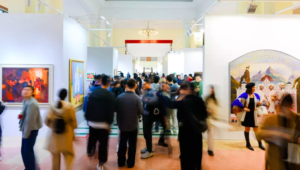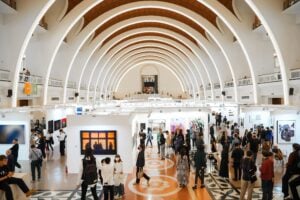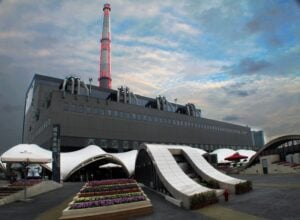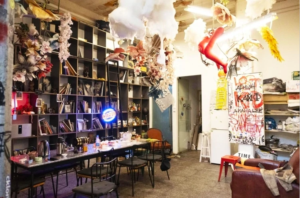Shanghai: A More Diverse Cultural Hub
Historically, Shanghai has been the cradle of Chinese contemporary art, as well as a bridge with Western culture. Over the past decade, the city has seen an exponential development of art galleries, museums, cultural districts and art fairs, which reflects the city’s ambition to become an ever-growing global art hub echoing both its rich cultural heritage and its rapid modernisation.
Shanghai art fairs on the global stage
Besides the Shanghai Biennale – China’s longest-running contemporary art biennale launched in 1996 and hosted at the Power Station of Art since 2012 – one of the most significant drivers of Shanghai’s art scene evolution has been the rise of new art fairs in the last ten years.
Art021 Shanghai, launched in 2013, quickly became a cornerstone of Shanghai’s art calendar, attracting galleries, collectors and art enthusiasts from around the world. The fair showcases a diverse array of contemporary art, offering a platform for both established and emerging artists, and has helped to foster an environment of collaboration and dialogue among various stakeholders in the art world.
West Bund Art & Design, organised by the local district government since 2014, has also grown in prominence. The fair spans across multiple venues, including the new Orbit exhibition centre designed by Heatherwick Studio. This event provides a platform for galleries to showcase a wide range of artworks, from affordable pieces to high-end investments.
PHOTOFAIRS Shanghai, established in 2014 in response to a growing enthusiasm for collecting photography, is the leading platform for contemporary photography in China and has firmly embedded the medium within the local cultural landscape.
These fairs have not only increased the visibility of the homegrown art scene but have also encouraged local collectors to engage with the global art market. The presence of high-profile international galleries and collectors has catalysed a shift in the local art economy, driving demand for contemporary Chinese art and promoting cross-cultural exchanges.
Museums: A testament to Shanghai’s commitment to preserving cultural heritage and promoting contemporary art
A notable museum is the Rockbund Art Museum, created in 2010 and located in the former Royal Asiatic Society building, which was one of the first modern museums in China. The museum focuses on contemporary art and hosts a wide range of exhibitions by both established and emerging artists.
The past decade has also witnessed the opening of several key museums that have further enriched the local cultural landscape. The Shanghai Museum of Contemporary Art (MOCA) and the Power Station of Art (PSA) are perfect examples of institutions that have embraced contemporary art, providing expansive exhibition spaces and innovative programming.
The Shanghai Museum of Contemporary Art opened in 2005 in People’s Park and was the first independent and non-profit contemporary art museum in Shanghai. Focusing on the promotion of Chinese and international contemporary art, the museum organises diverse exhibitions including both well-known and fledgling contemporary Chinese artists, as well as retrospectives for leading names of the fashion and creative world.
The Power Station of Art (2012), China’s first state-run museum of contemporary art, is a prime example of the city’s commitment to showcasing contemporary art and promoting cultural exchange. Housed in a converted power station, the museum has become a symbol of Shanghai’s artistic transformation and is known for hosting the Shanghai Biennale.
The establishment of private museums, like the Long Museum (2012) and the Yuz Museum (2014), has also diversified the art landscape in the city. These institutions are not only dedicated to showcasing contemporary art but they also emphasise the importance of integrating international works with local talents, fostering a sense of community and cultural exchange.
Shanghai art districts and creative hubs
Shanghai’s art districts have emerged as vibrant creative hubs that reflect the city’s diverse artistic expressions.
M50, named after after its address 50 Moganshan Road and located in a former textile factory, is known for its avant-garde and experimental art exhibitions, showcasing the works of emerging artists from China and beyond. This district hosts numerous galleries, artist studios and design shops, creating an ecosystem that encourages collaboration and innovation. It is often compared with New York’s SoHo and Beijing’s 798 Art Zone.
Another notable area is the West Bund cultural district, established in 2011 on an industrial zone with old factories. The district’s transformation is indicative of Shanghai’s broader urban development, as old industrial sites are repurposed into cultural spaces to stimulate creativity and community engagement.
The West Bund Art Center (2015), located in an old Shanghai aircraft factory, has become a focal point for contemporary art, hosting high-profile exhibitions and performances that draw both local and international audiences.
The latest museum, Art Bund Museum (2019) aims to create an open and cozy interdisciplinary cultural center. The museum also collaborates with Centre Pompidou to promote Chinese culture in the world and bring culture from all around the globe to Chinese audiences through semi-permanent exhibitions and feature exhibitions.
Shanghai art scene’s evolution: A reflection of China’s growth
At the forefront of the evolution of Shanghai’s art scene over the past decade, is China’s rapid economic growth, with an increase in disposable income among the burgeoning middle class. This demographic shift has resulted in a growing interest in art collecting and a greater appreciation for contemporary art as a form of cultural capital.
Besides, the globalisation of the art market has opened avenues for cross-cultural exchange. Shanghai’s strategic position as a gateway to China has attracted international galleries, artists and collectors, facilitating collaborations that enrich the local art environment.
One of the significant catalysts for Shanghai’s art scene has also been the generous land subsidies provided by the Chinese government for cultural enterprises. This support has facilitated the creation of cultural corridors like West Bund.
Ultimately, technological advancements have also transformed the way art is produced, distributed and consumed. The rise of social media platforms has enabled artists to reach wider audiences, while online sales platforms have made art more accessible to a broader range of collectors. This democratisation of art has encouraged a more diverse and inclusive art scene.



